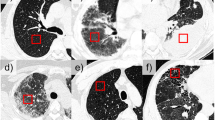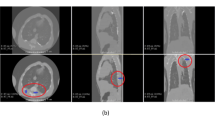Abstract
This study investigated the influence of iterative reconstruction (IR) methods on computed tomography (CT) images when training convolutional neural network (CNN) models to diagnose pulmonary emphysema. To evaluate the influence of the IR algorithm on CNN, the present study comprised two steps: the comparison of noise reduction by IR algorithms using phantom examinations and the change in performance of CNN with IR algorithms using patient data. We retrospectively analyzed 97 patients. Raw CT data were reconstructed using the filtered back-projection (FBP) and adaptive statistical iterative reconstruction V (ASIR-V) algorithms with blending levels of 30%, 50%, and 70%. The models were trained using reconstructed CT images and were named the FBP, ASIR-V30, ASIR-V50, and ASIR-V70 models. The mean and the standard deviation of the CT values were 11.3 ± 21.2 at FBP, 11.0 ± 17.3 at ASIR-V30, 11.0 ± 14.4 at ASIR-V50, and 11.0 ± 11.8 at ASIR-V70. For all the evaluation metrics, the best values were obtained with the FBP model applied to the ASIR-V70 test images. The worst values were obtained with the ASIR-V70 model applied to the FBP test images. The model trained with FBP images exhibited significantly better performance than the models trained using IR images. The reduction in image noise with the IR algorithm on the test images contributed to improving the accuracy of the classification of emphysema subtypes using CNN.






Similar content being viewed by others
References
GBD. Chronic respiratory disease collaborators, global, regional, and national deaths, prevalence, disability-adjusted life years, and years lived with disability for chronic obstructive pulmonary disease and asthma, 1990–2015: a systematic analysis for the global burden of disease study 2015. Lancet Respir Med. 2015;2017(5):691–706.
Vestbo J, Hurd SS, Agusti AG, et al. Global strategy for the diagnosis, management, and prevention of chronic obstructive pulmonary disease: GOLD executive summary. Am J Respir Crit Care Med. 2013;187:347–65.
Nishio M, Nakane K, Kubo T, et al. Automated prediction of emphysema visual score using homology-based quantification of low-attenuation lung region. PLoS One. 2017;12: e0178217.
Lynch DA, Austin JHM, Hogg JC, et al. CT-definable subtypes of chronic obstructive pulmonary disease: a statement of the fleischner society. Radiology. 2015;277:192–205.
Nambu A, Zach J, Kim SS, et al. Significance of low-attenuation cluster analysis on quantitative CT in the evaluation of chronic obstructive pulmonary disease. Korean J Radiol. 2018;19:139–46.
Jarnalo COM, Linsen PVM, Blazís SP, et al. Clinical evaluation of a deep-learning-based computer-aided detection system for the detection of pulmonary nodules in a large teaching hospital. Clin Radiol. 2021;76:838–45.
Blazís SP, Dickerscheid DBM, Linsen PVM, et al. Effect of CT reconstruction settings on the performance of a deep learning based lung nodule CAD system. Eur J Radiol. 2021;136: 109526.
Xu C, Qi S, Feng J, et al. DCT-MIL: deep CNN transferred multiple instance learning for COPD identification using CT images. Phys Med Biol. 2020;65: 145011.
Bermejo-Peláez D, Ash SY, Washko GR, et al. Classification of interstitial lung abnormality patterns with an ensemble of deep convolutional neural networks. Sci Rep. 2020;10:338.
Humphries SM, Notary AM, Centeno JP, et al. Deep learning enables automatic classification of emphysema pattern at CT. Radiology. 2020;294:434–44.
Mets OM, Willemink MJ, de Kort FP, et al. The effect of iterative reconstruction on computed tomography assessment of emphysema, air trapping and airway dimensions. Eur Radiol. 2012;22:2103–9.
Castaldi PJ, Estépar RSJ, Mendoza CS, et al. Distinct quantitative computed tomography emphysema patterns are associated with physiology and function in smokers. Am J Respir Crit Care Med. 2013;188:1083–90.
Lim K, Kwon H, Cho J, et al. Initial phantom study comparing image quality in computed tomography using adaptive statistical iterative reconstruction and new adaptive statistical iterative reconstruction V. J Comput Assist Tomogr. 2015;39:443–8.
Chen L, Jin C, Li J, et al. Image quality comparison of two adaptive statistical iterative reconstruction (ASiR, ASiR-V) algorithms and filtered back projection in routine liver CT. Br J Radiol. 2018;91:20170655.
Krizhevsky A, Sutskever I, Hinton GE. Imagenet classification with deep convolutional neural networks. Adv Neural Inform Proc Syst. 2012;25:1097–105.
Zeiler MD. ADADELTA: an adaptive learning rate method. arXiv. 2012;1212.5701
Goddard PR, Nicholson EM, Laszlo G, et al. Computed tomography in pulmonary emphysema. Clin Radiol. 1982;33:379–87.
Kagimoto A, Mimura T, Miyamoto T, et al. Severity of emphysema as a prognosticator of resected early lung cancer: an analysis classified by Goddard score. Jpn J Clin Oncol. 2020;5(50):1043–50.
Selvaraju RR, Cogswell M, Das A, et al. Grad-CAM: visual explanations from deep networks via gradient-based localization, 2017 IEEE International Conference on Computer Vision (ICCV). Venice: IEEE. 2017;618–626
Gao Y, Xiong J, Shen C, et al. Improving robustness of a deep learning-based lung-nodule classification model of CT images with respect to image noise. Phys Med Biol. 2021;7(66):10.
Funding
The authors state that this work has not received any funding.
Author information
Authors and Affiliations
Corresponding author
Ethics declarations
Conflict of interest
The authors declare that they have no conflicts of interest.
Ethical approval
This study was approved by the Ethics Committee of Teikyo University (approval number: 19-036-2).
Additional information
Publisher's Note
Springer Nature remains neutral with regard to jurisdictional claims in published maps and institutional affiliations.
About this article
Cite this article
Takeshita, T., Nambu, A., Tago, M. et al. The influence of image reconstruction methods on the diagnosis of pulmonary emphysema with convolutional neural network. Radiol Phys Technol 16, 488–496 (2023). https://doi.org/10.1007/s12194-023-00736-z
Received:
Revised:
Accepted:
Published:
Issue Date:
DOI: https://doi.org/10.1007/s12194-023-00736-z




